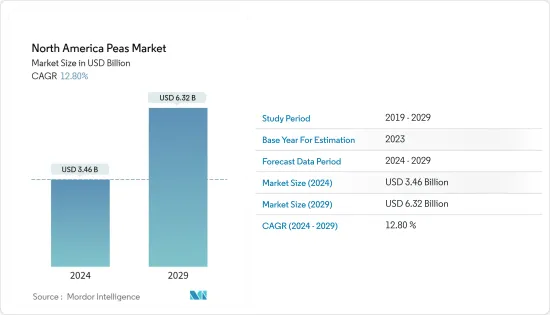PUBLISHER: Mordor Intelligence | PRODUCT CODE: 1444755

PUBLISHER: Mordor Intelligence | PRODUCT CODE: 1444755
North America Peas - Market Share Analysis, Industry Trends & Statistics, Growth Forecasts (2024 - 2029)
The North America Peas Market size is estimated at USD 3.46 billion in 2024, and is expected to reach USD 6.32 billion by 2029, growing at a CAGR of 12.80% during the forecast period (2024-2029).

Key Highlights
- Peas are annual pulse legume crops consumed throughout North America and grown in cold climates. Peas are the second most valuable canned food after tomatoes in the United States. The region's economic and sustainable land base with a good transportation network makes it an ideal location to grow peas.
- According to the FAO, in the United States, the total area harvested for green peas accounted for 51,193 hectares in 2020, followed by 52,448 hectares in 2021. Rising adoption of frozen vegetable imports rose by 9% to USD 1.4 billion. Imports continued to garner ever-larger shares of domestic markets for frozen green peas in 2022.
- The demand for plant protein has gained traction in North America. North America accounted for the major global revenue share, dominating the pea protein industry. Consumption of high-protein food has increased rapidly in response to rising health consciousness. Consumers are driven to find nutrients in packaged food products, creating a significant market for pea protein powder and driving the region's pea market.
- North America is the world's largest producer and exporter of dried peas. Canada dominates the region's pea production and export market, with a volume of 2.2 million metric ton production in 2021, followed by the United States. The varieties of peas grown in the region are yellow, green, and Austrian winter peas. Yellow and green peas account for two-thirds of North American peas production.
North America Peas Market Trends
Growing Demand for Pea Protein
With consumers being more conscious about their health, the demand for healthy and low-fat food has increased globally, and this has motivated the intake of vegan diets among health-conscious people. The growing trend of veganism worldwide is also fueling plant protein-based products in countries such as the United States and Canada.
Peas have played a significant role in overcoming challenges associated with protein-energy malnutrition in developing and under-developed countries, thereby driving the growth of the yellow peas market globally. Thus, the rush to introduce new products based on plant protein and a spike in demand due to rising vegetarians in several countries boosted the growth of the yellow peas market in the study period.
The growing demand from consumers and an increasing focus on non-GMO and gluten-free products are expected to stimulate the pea protein market and drive its growth. The cost of organic pea protein is strongly driven by the product's manufacturing method, the qualities of the obtained product, and the demand for textured pea protein in meat processing creating a huge opportunity for pea protein ingredients.
Increasing Export Demand of Peas from United States and Canada
Liberalization of the US-Mexico Dry Bean Trade, as part of the North American Free Trade Agreement (NAFTA), has enabled the US dry bean producers to export their products to other North American countries, aiding the dry bean exports from the United States to Mexico and Canada.
The total export of peas from Canada to the world in 2021 was 2.76 million metric ton, a decrease of 28.1% from 2020, owing to the decrease in Canadian dry pea production by 50.8% between 2020 and 2021. The average price is expected to be sharply higher than in 2020-2021 due to lower global supply and decreased carry-out stocks in Canada. The major export markets for Canadian peas are Southeast Asian countries, such as China, Japan, Bangladesh, Sri Lanka, and Central and South America.
The total global export of the United States in 2021 was 0.21 million metric ton, down by 6.6% from the previous year. According to the US Department of Agriculture, the area seeded to dry peas in the United States declined by 3% between 2020 and 2021 to about under 1.0 million acres, largely due to higher abandonment and lower yields in the country. More than 70% of the total US dry pea production is exported to India, China, and Spain for food and feed processing. The United States ranks eighth in the global import of peas.
North America Peas Industry Overview
Additional Benefits:
- The market estimate (ME) sheet in Excel format
- 3 months of analyst support
TABLE OF CONTENTS
1 INTRODUCTION
- 1.1 Study Assumptions and Market Definition
- 1.2 Scope of the Study
2 RESEARCH METHODOLOGY
3 EXECUTIVE SUMMARY
4 MARKET DYNAMICS
- 4.1 Market Overview
- 4.2 Market Drivers
- 4.3 Market Restraints
- 4.4 Value Chain Analysis
5 MARKET SEGMENTATION
- 5.1 United States
- 5.1.1 Production Analysis
- 5.1.2 Consumption Analysis
- 5.1.3 Import Analysis by Volume and Value
- 5.1.4 Export Analysis by Volume and Value
- 5.1.5 Price Trend Analysis
- 5.2 Canada
- 5.2.1 Production Analysis
- 5.2.2 Consumption Analysis
- 5.2.3 Import Analysis by Volume and Value
- 5.2.4 Export Analysis by Volume and Value
- 5.2.5 Price Trend Analysis
- 5.3 Mexico
- 5.3.1 Production Analysis
- 5.3.2 Consumption Analysis
- 5.3.3 Import Analysis by Volume and Value
- 5.3.4 Export Analysis by Volume and Value
- 5.3.5 Price Trend Analysis
6 MARKET OPPORTUNITIES AND FUTURE TRENDS




